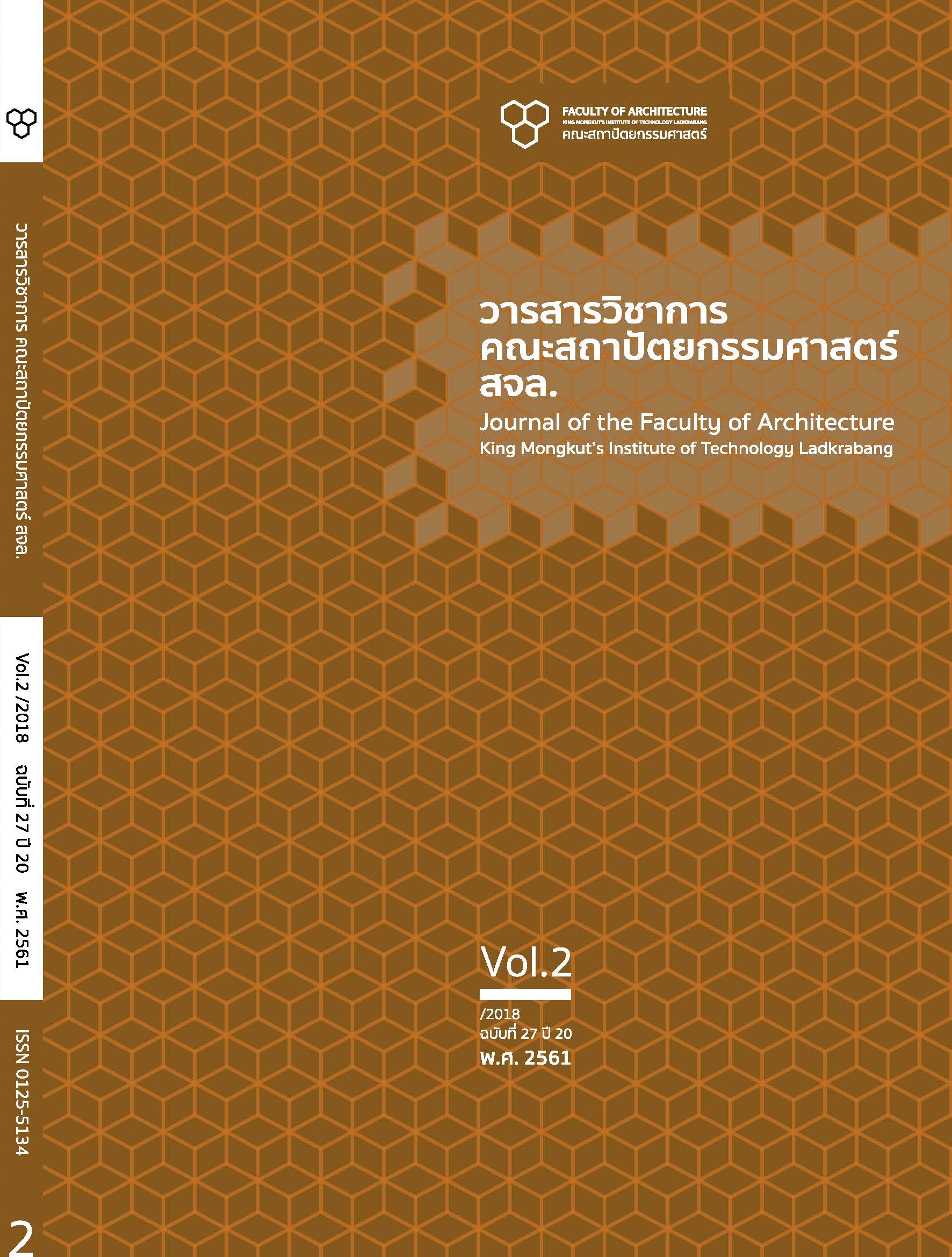การศึกษาแบบจำลองค่าพลังงานไฟฟ้าการปรับอากาศและระยะเวลาการคืนทุนของการใช้ฉนวนกันความร้อนในกรอบอาคารพักอาศัยประเภทบ้านเดี่ยว Simulation Study of Air-Conditioning Energy Consumption and Payback Period of Using Thermal Insulation in the Detached Houses
Main Article Content
Abstract
บทคัดย่อ
การวิจัยนี้มีวัตถุประสงค์เพื่อประเมินผลจากการใช้ฉนวนกับบ้านพักอาศัยในด้านการลดพลังงานไฟฟ้าในการปรับอากาศและด้านความคุ้มทุนสาหรับบ้านเดี่ยว วิธีการศึกษาได้แก่การสร้างแบบจำลองทางพลังงานของบ้านเดี่ยว กรณีฐานในโปรแกรมจำลองทางพลังงาน eQuest 3.65 ซึ่งจะคำนวณค่าพลังงานไฟฟ้าของบ้านกรณีฐานได้โดยใช้ข้อมูลสภาพอากาศของกรุงเทพมหานคร ค.ศ.1998-2002 ซึ่งสร้างขึ้นในรูปแบบไฟล์ Typical Meteorological Year (TMY) บ้านเดี่ยวกรณีฐานมีข้อมูลของปัจจัยต่างๆ ของบ้านที่ส่งผลต่อการใช้พลังงานไฟฟ้าในการปรับอากาศ งานวิจัยนี้ได้สร้างแบบจำลองบ้านกรณีฐานขึ้นมาแล้วนำผลการจำลองทางพลังงานมาเปรียบเทียบกับการใช้ไฟฟ้าที่เก็บข้อมูลได้จากบ้านจริง ซึ่งได้พบว่าพลังงานไฟฟ้าในการปรับอากาศของบ้านกรณีฐานและบ้านจริงมีความแตกต่างเฉลี่ย 12 เดือน เท่ากับ 10.2% ดังนั้นแบบจำลองบ้านกรณีฐานสามารถเป็นตัวแทนการใช้พลังงานในการปรับอากาศของบ้านทั่วไปได้ จากนั้นได้ป้อนข้อมูลการติดตั้งฉนวนหนา 75 และ 150 มม. ที่ผนังและ/หรือเพดานในแบบจำลองบ้านกรณีฐาน ซึ่งหันไปทางทิศเหนือ ใต้ตะวันออกและตะวันตก แล้วคำนวณค่าพลังงานไฟฟ้าในการปรับอากาศจากการใช้ฉนวนดังกล่าว ผลการศึกษาพบว่าการติดตั้งฉนวนสามารถลดพลังงานไฟฟ้าในการปรับอากาศลงได้ 19.08-38.8% เมื่อเทียบกับกรณีที่ไม่ติดฉนวนบ้านที่หันไปทางทิศใต้และมีการติดตั้งฉนวนที่ฝ้าเพดานมีการลดลงของ พลังงานในการปรับอากาศมากที่สุดโดยสามารถคืนทุนได้เร็วที่สุด 0.9 ปีเมื่อติดตั้งกับฝ้าเพดานเดิมโดยไม่ต้องลงทุนโครงสร้างเพิ่มเติม การติดฉนวนที่ผนังอย่างเดียวสามารถ คืนทุนได้เร็วที่สุดคือ 5 ปี โดยติดตั้งฉนวนหนา 75 มม. กับผนังภายนอกของบ้านที่หันไปทางทิศใต้
คำสำคัญ: แบบจำลองทางพลังงานของอาคาร ภาระการทำความเย็น การต้านทานความร้อน ค่าพลังงานไฟฟ้า ระยะเวลาคืนทุน
Abstract
The purpose of this research is to evaluate the effect of insulation on electric energy consumption in air conditioning and the cost-effectiveness of using insulation in the detached houses. A model of Base Case house was simulated in eQuest 3.65, a building energy simulation program, to calculate the baseline energy under the Bangkok meteorological data year 1998-2002 generated in Typical Meteorological Year (TMY) format. The Base Case was a single-detached house contained information on various factors affecting the use of electrical energy in air conditioning. This research constructed and simulated the Base Case model and compared the simulated results with the electric consumption collected from a real house. It was found that the electric consumption in the Base Case averagely differences from the real house by 10.2 %. Therefore, the Base Case model can represent the energy consumption of the house. Then, the fiberglass insulation of 75 and 150 mm thickness were input into the Base Case model facing North, South, East and West. The results showed that insulation can reduce electrical energy in air conditioning by 19.08-38.8% compared to the non-insulated Base Case. The south facing house with insulated ceiling showed highest electric energy reduction. The 75 mm insulation installed over 194 the original ceiling without additional frame investment gave the fastest payback of 0.9 years. Wall insulation needed frames and finishing boards can pay off at 5 years by installing insulation with a 75 mm thickness on the exterior wall of the house facing south.
Keywords: Building Energy Simulation, Cooling Load, Heat Resistance, Energy Consumption, Payback Period
Article Details
This work is licensed under a Creative Commons Attribution-NonCommercial-ShareAlike 4.0 International License.
Copyright Transfer Statement
The copyright of this article is transferred to Journal of The Faculty of Architecture King Mongkut's Institute of Technology Ladkrabang with effect if and when the article is accepted for publication. The copyright transfer covers the exclusive right to reproduce and distribute the article, including reprints, translations, photographic reproductions, electronic form (offline, online) or any other reproductions of similar nature.
The author warrants that this contribution is original and that he/she has full power to make this grant. The author signs for and accepts responsibility for releasing this material on behalf of any and all co-authors.
References
ณัฐฐาอัมพร อินทร์พรหม. (2558). การวิเคราะห์ความไวของอิทธิพลตัวแปรองค์ประกอบกรอบอาคารที่มีผลต่อปริมาณการใช้พลังงานไฟฟ้าของเครื่องปรับอากาศในบ้านจัดสรรประเภทบ้านเดี่ยว. (วิทยานิพนธ์สถาปัตยกรรมศาสตรมหาบัณฑิต , มหาวิทยาลัยธรรมศาสตร์).บริษัท ปูนซิเมนต์ไทย จำกัด (มหาชน). (2559). ฉนวนกันความร้อน เอสซีจี รุ่น STAY COOL. เข้าถึงได้จาก: http://www.scgbuildingmaterials.com.
พันธุดา พุฒิไพโรจน์. (2554). การติดตั้งแผ่นฉนวนกันความร้อนจากวัสดุเหลือใช้ทางการเกษตรในแผ่นคอนกรีตสำเร็จรูป. วารสารหน้าจั่ว . 25(2011), 389-401.
สถาบันเทคโนโลยีพระจอมเกล้าเจ้าคุณทหารลาดกระบัง. (2556). รายการประมาณราคา งานปรับปรุงพื้นที่ .กรุงเทพมหานคร: สถาบันเทคโนโลยีพระจอมเกล้าเจ้าคุณทหารลาดกระบัง.
สำนักงานพัฒนาวิทยาศาสตร์และเทคโนโลยีแห่งชาติ. (2560). พลังวิทย์ คิดเพื่อคนไทย ตอน ฉนวนความร้อนทนไฟจากฟางข้าวผสมกับเยื่อสา. เข้าถึงได้จาก: http://nstdachannel.tv/20171129-palangvit.
สำนักงานนโยบายและแผนพลังงาน. (2558). Policy and Planning. เข้าถึงได้จากhttp://www.eppo.go.th.
สำนักงานนโยบายและแผนพลังงาน. (2561). กำลังผลิต การผลิต ค่าพลังไฟฟ้าสูงสุด การใช้ การนำเข้า การส่งออกและเชื้อเพลิงที่ใช้ในการผลิตไฟฟ้า. เข้าถึงได้จาก: http://www.eppo.go.th.
อนุภา สกุลพาณิชย์. (2559). การพัฒนาฉนวนกันความร้อนสู่อาคารจากซังข้าวโพดและน้ำยางธรรมชาติ. วารสาร Veridian E-Journal, Silpakorn University. 9 (1), 1688-1702.
อุมาพร จันธิมา, สิริมาส เฮงรัศมี, สันต์ จันทร์สมศักดิ์ และสุทัศน์ เยี่ยมวัฒนา. (2560). การออกแบบผนังและเปลือกอาคารเพื่อประหยัดพลังงานสาหรับอาคารอเนกประสงค์ มหาวิทยาลัยนเรศวร. วารสาร เจ-ดี: การออกแบบสภาพแวดล้อม. 4(2), 69-82.
Jareemit, D. and Inprom, N. (2015). Review Article: Significant Parameters in Building Energy Simulation. Journal of Architectural Research and Studies. 12(1), 1-14.
Hirsch, J.J. and Associates. (2009). DOE 2.2 Building Energy Use and Cost Analysis Program: Volume 4 Library and Reports. California: Lawrence Berkeley National Laboratory.


